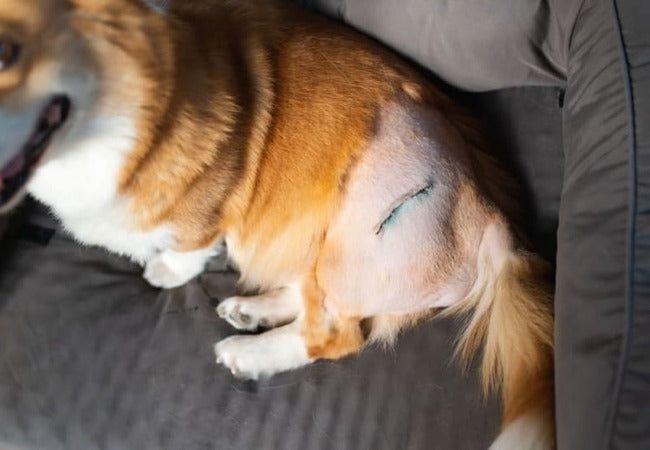Vet‑Approved 2025 Guide: Hip Dysplasia Surgery in Dogs – Procedures, Recovery & Enrichment 💉🐶

In this article
Vet‑Approved 2025 Guide: Hip Dysplasia Surgery in Dogs – Procedures, Recovery & Enrichment 💉🐶
By Dr. Duncan Houston BVSc
Hip dysplasia is a hereditary condition where the hip joint's ball and socket don’t fit properly, leading to pain, joint laxity, and osteoarthritis over time. In this detailed 2025 vet‑approved guide by Dr Duncan Houston BVSc, you’ll learn about surgical options—from preventive procedures in puppies to reconstructive solutions in adults—costs, recovery protocols, risks, and how to enrich your dog’s healing journey with tools from Ask A Vet. 🐾✨
🔍 What Is Hip Dysplasia & Who Is Affected?
Genetics, rapid growth, excess weight, and over‑exercise during puppyhood contribute to hip dysplasia, especially in large breeds like German Shepherds, Labs, Retrievers, Saint Bernards, Rottweilers, and Bulldogs. Some dogs show pain early, others remain asymptomatic until arthritis develops.
📋 Indications for Surgery
Surgery is recommended when conservative management fails or when early intervention can prevent arthritis: clinical signs like limping, bunny‑hopping, reluctance to stand/jump, confirmed radiographs, and impact on quality of life.
🛠️ Surgical Options
1. Juvenile Pubic Symphysiodesis (JPS)
Performed on puppies 10–18 weeks old, it closes a pelvic growth plate to improve hip congruity. Minimally invasive, often outpatient, and reverses looseness in ~74% of pups.
2. Double/Triple Pelvic Osteotomy (DPO/TPO)
For puppies under 8–10 months without arthritis: the pelvis is cut and rotated to improve hip fit, then stabilized with plates/screws. It avoids degenerative joint disease and yields excellent function (~86–92%).
3. Femoral Head Ostectomy (FHO)
Removing the femoral head to allow scar-tissue “false joint” formation. Ideal for small dogs or those where full joint replacement isn’t feasible. ~63% good to excellent outcomes.
4. Total Hip Replacement (THR)
Prosthetic replacement of both ball and socket; considered gold standard in arthritis cases. Restores near-normal function in 80–98% of dogs. Recovery takes ~12 weeks.
💰 Cost Estimates
- JPS: typically < $1,500, outpatient
- DPO/TPO: $3,000–5,000 depending on implants and rehab.
- FHO: $1,500–4,000 plus rehab costs.
- THR: $3,500–10,000 per hip, including surgery, implants, and hospital stay.
Insurance, payment plans (CareCredit), or clinic financial assistance may help offset costs.
⚠️ Risks & Complications
- Infection, hemorrhage, nerve or tissue damage, and implant failure.
- Potential pelvic canal narrowing after TPO/DPO; FHO may cause altered gait or shorter limb.
- THR risk: implant loosening or fracture, though low in expert hands.
Choosing board-certified surgeons reduces complication rates significantly.
🩺 Preparing for Surgery
- Pre-op bloodwork, physical exam, and imaging.
- Fast 8–12 hrs before surgery.
- IV catheter, pain medication, and possibly epidural before anesthesia.
- Sterile prep, shaving, and proper positioning on the OR table.
🔧 Post‑Op Care & Recovery
- Strict crate rest for ~6 weeks initially.
- Controlled leash walks and slow reintroduction of activity.
- Hospital stay ranges from same-day (JPS) to 1–3 days (THR).
- Start physical therapy 2–4 weeks post-surgery.
- Full mobility generally returns by 4–6 months.
🐕 Rehabilitation Essentials
- Hydrotherapy for muscle rebuilding.
- Physiotherapy techniques: passive range-of-motion, massage.
- Joint supplements (glucosamine, omega-3s), weight management.
- Use calming tools during recovery: calming wraps, lick mats, and pheromone diffusers.
Enrichment during rest is essential—combine Ask A Vet telemedicine for progress checks, calming aids for stress-free healing.
🏁 Long‑Term Outlook
These surgeries aim to restore pain-free mobility and improve quality of life: TPO yields tight hips in ~86–92%, FHO offers good outcomes in ~63%, and THR has 80–98% success.
Post-surgery, maintaining optimal weight, regular gentle exercise, and joint supplements help preserve results.
🚨 When to Contact Your Vet
- Signs of infection: redness, discharge, swelling at incision.
- Unusual limping or reluctance to bear weight.
- Fever, appetite loss, or behavioral changes during recovery.
🏁 Final Thoughts
Hip dysplasia surgery offers transformative outcomes—from preventing arthritis in puppies to restoring mobility in adult dogs. With modern surgical techniques, expert surgeons, structured rehab, and supportive enrichment tools from Ask A Vet,, your dog can return to a vibrant, active life. 🐾❤️
Need personalized guidance or want to discuss your dog’s case? Visit Ask A Vet, explore calming aids from, and embark on the road to recovery with confidence and care! 🐶✨


